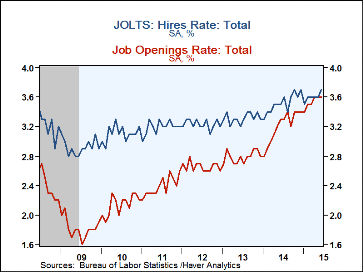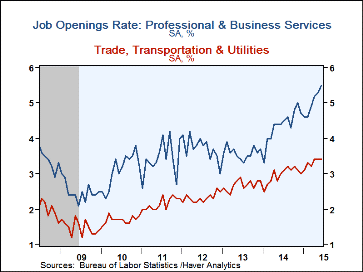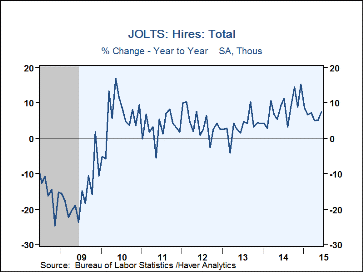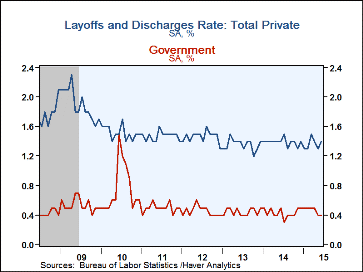 Global| Aug 12 2015
Global| Aug 12 2015U.S. JOLTS: Job Openings Rate Remains Near 2001 High; Hiring Strengthens
by:Tom Moeller
|in:Economy in Brief
Summary
The job openings rate during June held steady at 3.6% for the third straight month, just below the series' high of 3.8% in January 2001. The rate is improved from the low of 1.6% in July 2009. The job openings rate is the number of [...]
The job openings rate during June held steady at 3.6% for the third straight month, just below the series' high of 3.8% in January 2001. The rate is improved from the low of 1.6% in July 2009. The job openings rate is the number of job openings on the last business day of the month as a percent of total employment plus job openings. The hires rate improved to 3.7% from an upwardly revised 3.6%. The latest figure equaled the December high. The hires rate is the number of hires during the month divided by employment. The Bureau of Labor Statistics reports these figures in its Job Openings & Labor Turnover Survey (JOLTS).
The actual number of job openings increased 11.4% y/y to 5.294 million but they were down 2.0% from May's high. Despite the strength in job openings, firms' ability to fill the positions remained under pressure. Hiring grew a lesser 7.4% y/y and June's level of 5.177 million was down from December's high of 5.239 million.
The private-sector job openings rate eased to 3.8% but remained improved from the recession low of 1.7%. The rate in professional & business services rose further to a recovery high of 5.5% while the rate in leisure & hospitality declined to 4.3% from 4.6% and remained below the May 2014 high of 4.9%. In health care & social services, the rate held at the eight-year high of 4.6% for the third straight month. In trade, transportation & utilities, it held at the record high of 3.4% for the third straight month. The rate in the factory sector declined to 2.4% after five months at 2.6% and the construction sector's rate eased to 2.2% from the 2.6% expansion high three months earlier. The job openings rate in the government sector held for the fifth straight month at 2.2%, higher than the 2009 low of 1.1%.
The private sector hires rate held m/m at 4.0%, down from December's high of 4.1%. Amongst leisure & hospitality firms, the rate eased to 6.1%, about where it's been for nine months and the rate in professional & business services slipped to 5.2%, off the September high of 5.8%. The construction sector rate nudged higher to 5.2%, still down from the December high of 7.0%. In retail trade, it rose to 5.1%, equaling the highest point since November 2007. The hiring rate in education & health services remained at 2.7% for a fourth month but in the factory sector, it rebounded to a six-month high of 2.2%. In the government sector, the hiring rate held at 1.5% for the fourth month, up from the 2014 low of 1.3%.
The number of private sector hires rebounded 2.6% (7.3% y/y). Construction sector hiring grew by one-quarter y/y. Education & health services employment rose 8.1% y/y and trade, transportation & utilities jobs increased 5.7% y/y. That was accompanied by a 5.2% increase in leisure & hospitality and a 3.9% rise in professional & business services. Factory sector hiring rose 0.4% y/y and government sector jobs grew 9.1% y/y.
The job separations rate edged up to 3.5% and the actual number of separations increased 9.0% y/y. Separations include quits, layoffs, discharges, and other separations as well as retirements. The private sector separations rate rose to 3.9% while the government sector's rate eased to 1.4% after five months at 1.5%. The layoff & discharge rate notched up to 1.3%. The private sector layoff rate rose to 1.4%, about where it's been for three years, and the government's rate held at 0.4%.
The JOLTS survey dates to December 2000 and the figures are available in Haver's USECON database.
Do Monetary Policy Shocks Affect Trend Labor Productivity? from the Federal Reserve Bank of Kansas City can be found here.
| JOLTS (Job Openings & Labor Turnover Survey, SA) | Jun | May | Apr | Jun '14 | 2014 | 2013 | 2012 |
|---|---|---|---|---|---|---|---|
| Job Openings, Total | |||||||
| Rate (%) | 3.6 | 3.6 | 3.6 | 3.3 | 3.4 | 2.8 | 2.6 |
| Total (000s) | 5,249 | 5,357 | 5,334 | 11.4% | 22.6% | 9.3% | 3.2% |
| Hires, Total | |||||||
| Rate (%) | 3.7 | 3.6 | 3.6 | 3.5 | 42.2 | 39.8 | 38.8 |
| Total (000s) | 5,177 | 5,060 | 5,034 | 7.4% | 8.4% | 3.4% | 4.2% |
| Layoffs & Discharges, Total | |||||||
| Rate (%) | 1.3 | 1.2 | 1.3 | 1.2 | 14.5 | 14.6 | 15.5 |
| Total (000s) | 1,791 | 1,660 | 1,784 | 5.4 | 2.4% | -4.9% | 1.1% |
Tom Moeller
AuthorMore in Author Profile »Prior to joining Haver Analytics in 2000, Mr. Moeller worked as the Economist at Chancellor Capital Management from 1985 to 1999. There, he developed comprehensive economic forecasts and interpreted economic data for equity and fixed income portfolio managers. Also at Chancellor, Mr. Moeller worked as an equity analyst and was responsible for researching and rating companies in the economically sensitive automobile and housing industries for investment in Chancellor’s equity portfolio. Prior to joining Chancellor, Mr. Moeller was an Economist at Citibank from 1979 to 1984. He also analyzed pricing behavior in the metals industry for the Council on Wage and Price Stability in Washington, D.C. In 1999, Mr. Moeller received the award for most accurate forecast from the Forecasters' Club of New York. From 1990 to 1992 he was President of the New York Association for Business Economists. Mr. Moeller earned an M.B.A. in Finance from Fordham University, where he graduated in 1987. He holds a Bachelor of Arts in Economics from George Washington University.










